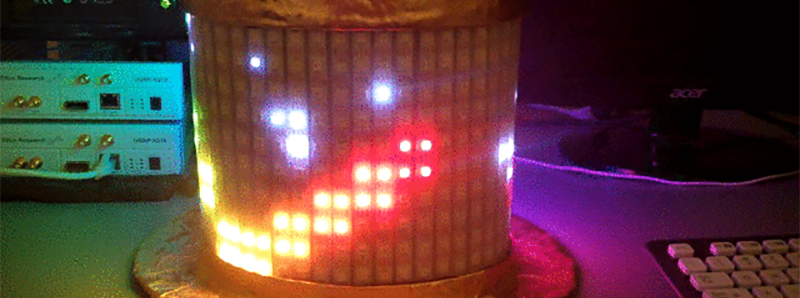There are a lot of blinky glowy things at Burning Man every year, and [Mark] decided he would literally throw his hat into the ring. He built a high visibility top hat studded with more RGB LEDs than common sense would dictate. It’s a flashy hat, and a very good example of the fashion statement a few hundred LEDs can make.
[Mark]’s top hat has 481 WS2812b addressable LEDs studded around the perimeter, a common LED choice for bright and blinky wearables. These LEDs are driven by a Teensy 3.1, with a Bluetooth transceiver, a GPS module, a compass, and gyro/accelerometer attached to the microcontroller. That’s a lot of hardware, but it gives [Mark] the capability of having the hat react to its own orientation, point itself North, and allow for control via a modified Nintendo NES controller.
The WS2812 LEDs draw a lot of power, and for any wearable project having portable power is a chief concern. [Mark]’s original plan was to use an 8x battery holder for the electronics enclosure, and use five AA batteries to power the hat. The total idle draw of the LEDs was 4.5 Watts, and with even a few LEDs blinking colors there was a significant voltage drop. The idea of powering the hat with AA batteries was discarded and the power source was changed to a 195 Watt-hour lithium ion battery bank that was topped off each day with a solar panel.
The hat is awesome, exceedingly bright, and something that gets a lot of attention everywhere it goes. For indoor use, it might be too bright, but this could be fixed with the addition of a bit of black stretchy fabric, like what our own [Mike Szczys] did for his DEF CON hat. [Mark]’s hat is just version 1, and he plans on making a second LED hat for next year.
















Cool project…though I’m more interested in what he’s doing with the two $1500 USRP SDR’s sitting next to his monitor.
His blog has a post about a “DARPA Spectrum Challenge” where he was awarded them, I guess he hasn’t had to return them (or it was still ongoing).
Add a 360° camera atop the hat and display the stream in pixelated form by the leds, and that would be impressive!
Not hard to do with a raspi camera and a simple cone lens to make it “360”
Already, a cone lens wouldn’t project a 360° image in a circle… a cone mirror would, but you would have to transform the image to make it planar which implies a huge loss of precision at the top of the cone
I was referring to those hexa cams used in latest videoconferencing devices, where each camera image is joined to the adjacent ones… that would require some nice computing power and hardware to render a live stream and for making it small it would require smart hacks actually
Dimming is easy – it’s “only” software. No need for stretchy black material with NeoPixels, just dial down the brightness in software.
That might be a little more battery friendly too.
It’s not just dimming that you get. These things look better softened a bit. And, it makes the hat look slightly more like a hat rather than a bunch of LED strings.
Including the onboard nuclear power plant, how much does it weigh?
Awesome